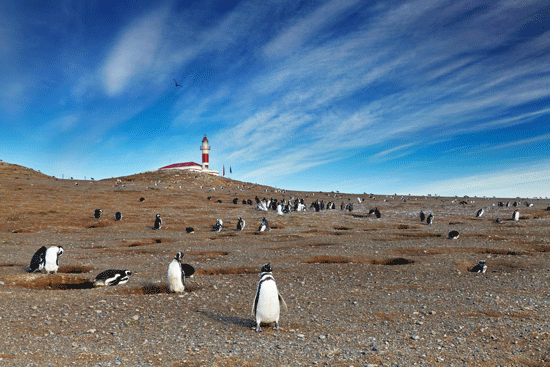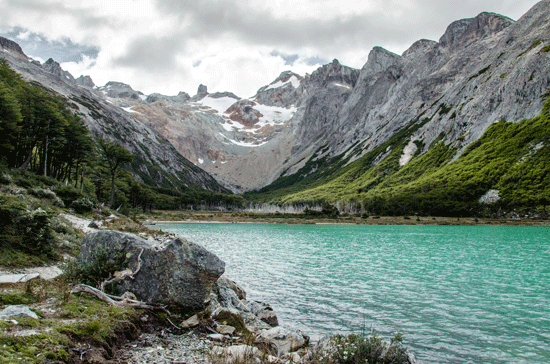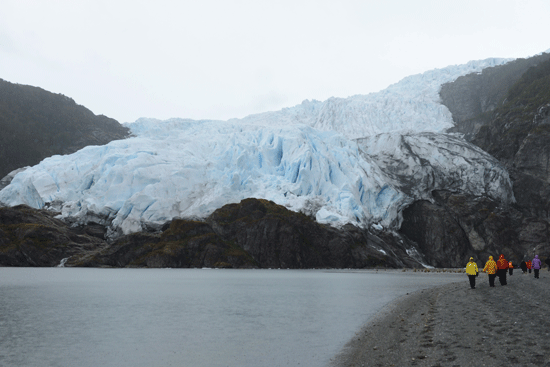
4 Must-See Natural Wonders of the Patagonian Frontier

August 21, 2019
4 minute read
The only sounds you hear are the wild winds across the steppe. The only sights you see are jagged mountain peaks and still, silver lakes. You are in the heart of a rugged wilderness carved by eons of slow-moving ice – you can feel the timelessness of the landscape. The natural beauty before you is the same that nomadic tribes looked upon thousands of years ago.
This Explorations experience to Patagonia will take you through this stark and stunning region that both Chile and Argentina share. Venture across lakes set like jewels in the Andes Mountains, and witness sights like the Perito Moreno Glacier. There, massive shards of ice break free from the glacier with a sound like rolling thunder, plunging into the waters below.
This is Patagonia.
The landscape today still feels untouched, even centuries after the exploration by the famed naturalist, Charles Darwin. To highlight a select few, these are some of the natural wonders you will discover as you explore the top things to do in the Patagonia frontier.
A remote island of 6 humans and 350,000 penguins
Magdalena Island is one of the most remote islands you’ll visit in Patagonia. The island is inhabited only by a handful of Park Rangers and an immense colony of at least 350,000 Magellanic penguins.
Ancient sailors and explorers stopped here to get supplies for expeditions. This list includes the famous Portuguese explorer Ferdinand Magellan – and so came the name of the iconic penguins.
The island landmark is its lighthouse, built in 1902. Its park rangers live in a building attached to the lighthouse. Six stay in the summer, and three in the winter – and it is important to note that first-year rangers are not permitted to volunteer for the extremely harsh winter duty.
The natural landscape of the island is rigorously preserved – visitors are only allowed to walk in designated paths so as to not disturb the wildlife. A view of this island is an experience that few get to share with the Magellanic penguins.
A glacier growing (against all odds)
Patagonia is one of the places suffering the worst from worldwide climate change. In this region, many of these amazing glaciers are sadly shrinking. There are just a few Patagonian glaciers, however, that continue to grow rather than shrink.
One of these growing glaciers is the Garibaldi Glacier – and it is quite the sight to see. It boasts shades of sapphire and teal as it appears to ooze into the sea. Distinguished by its “medial moraine,” or a formation of rocks and debris carried along as the glacier pushes through that was created by the meeting of two glaciers to create this one resilient glacier.
It’s somewhat of a mystery to scientists why these glacier buck typical patterns in the face of global warming. Theories include influences such as the depth and temperature of bodies of water at the edge of a glacier, or the steepness of mountains and fjords that support the bottom edges of a glacier.
The “Land of Fire” covered in snow and ice
Tierra del Fuego (translating to “Land of Fire”) National Park is so untamed that only a small portion of it is open to the public. Located just outside the southernmost city in the world, Ushuaia, this Argentine national park is teeming with natural drama.
It offers a quintessential view of the best of Patagonian nature. Its scenes are dotted with powerful waterfalls, lush forests, rugged mountains, and sparkling glaciers.
Contrary to the initial belief of many, the Tierra del Fuego region was not named such because of volcanoes or natural heat. Its name contrasts the cold weather and snowy peaks, but the region was named by its first European explorers, who spotted its native people burning fires along the coastline.
A blue-spattered glacier and its sparkling lagoon
The amazing Águila Glacier floats in a lagoon of its own formation. This glacier, though not one of Patagonia’s most famous, is a must-see. Stand at the shores of the lagoon, surrounded by an old and undisturbed forest, and ponder how this awe-inspiring scene was created.
The cracks of this glacier glitter an unbelievable shade of bright blue in perfect contrast to the rest of pearly white ice. As the glacier melts, it feeds its lagoon, and, as a chain reaction, the wildlife around the area flourish from its mineral-rich waters.
Bird life is especially prolific here, as they perch atop towering primeval trees and soar above the aptly named Águila “Eagle” Glacier.
…
Visit collette.com/explorations to learn more about our Patagonian experience and other Exploration tours.




